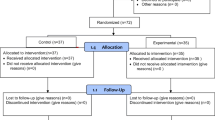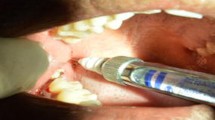Abstract
Objective
The aim of this study is to evaluate the effect of using anti-stress balls in reducing patients’ pain during injection of the inferior alveolar nerve block (IANB).
Materials and methods
In this randomized clinical trial, 32 individuals were divided into two groups. The conventional method of anesthesia injection was performed using IANB conventional injection technique. During the injection, individuals in the anti-stress ball group were asked to use the anti-stress ball as a distraction technique. For the control group, no supersede methods were used for pain control. Finally, both groups were asked to record their pain utilizing the numerical rating scale (NRS). The participants’ vital signs were monitored before and after injection. Kolmogorov-Smirnov test, independent T-test, and Fisher’s exact chi-square test were performed for statistical analysis (α = 0.05).
Results
Sixteen females and 16 males in the age range of 40 to 20 years old participated in this study. The mean pain score in the anti-stress ball group was significantly lower (p < 0.001). In both sexes, the pain score in the anti-stress ball group was significantly lower (males p < 0.001 and females p = 0.001). In addition, in all age ranges, the pain score in the control group was higher except for the above 35 years old participants (p = 0.078). Moreover, there were no significant differences in individuals’ vital signs (p > 0.05).
Conclusion and clinical relevance
Utilizing an anti-stress ball reduces patients’ pain significantly during IANB in both sexes and individuals who are below 35 years without changing vital signs.
Clinical registration number
IRCT20220815055704N1

Similar content being viewed by others
Data Availability
The datasets analyzed during the current study are not publicly available but are available from the corresponding author on reasonable request.
References
Eisenberger NI, Lieberman MD (2005) Why it hurts to be left out. The social outcast: ostracism, social exclusion, rejection, and bullying, p. 109–127
Brahm CO et al (2012) Dentists’ views on fearful patients. Problems and promises. Swed Dent J 36(2):79–89
Zhou X, Nanayakkara S (2022) Buccal infiltration with 4% articaine may be an alternative option to inferior alveolar nerve block with 2% lidocaine for pulp therapy in primary mandibular molars. J Evid Based Dent Pract 22(4):101801
Aydin D, Şahiner NC, Çiftçi EK (2016) Comparison of the effectiveness of three different methods in decreasing pain during venipuncture in children: ball squeezing, balloon inflating and distraction cards. J Clin Nurs 25(15–16):2328–2335
Kain ZN et al (2006) Preoperative anxiety, postoperative pain, and behavioral recovery in young children undergoing surgery. Pediatrics 118(2):651–658
Meulders A (2020) Fear in the context of pain: lessons learned from 100 years of fear conditioning research. Behav Res Ther 131:103635
Moaddabi A et al (2021) Effect of opaque eye coverage on anxiety in candidates for surgical removal of impacted third molars: a randomized clinical trial. Oral Surg Oral Med Oral Pathol Oral Radiol 132(3):267–272
Hoffmann B et al (2022) Management strategies for adult patients with dental anxiety in the dental clinic: a systematic review. Aust Dent J 67 Suppl 1(Suppl 1):S3-s13
Ruscheweyh R et al (2011) The effect of distraction strategies on pain perception and the nociceptive flexor reflex (RIII reflex). Pain 152(11):2662–2671
Appukuttan DP (2016) Strategies to manage patients with dental anxiety and dental phobia: literature review. Clin Cosmet Investig Dent 8:35–50
Barreiros D et al (2018) Audiovisual distraction methods for anxiety in children during dental treatment: a systematic review and meta-analysis. J Indian Soc Pedod Prev Dent 36(1):2–8
Hudson BF, Ogden J, Whiteley MS (2015) Randomized controlled trial to compare the effect of simple distraction interventions on pain and anxiety experienced during conscious surgery. Eur J Pain 19(10):1447–1455
Usichenko TI et al (2019) Mechanisms of “cough-trick” for pain relief during venipuncture: an experimental crossover investigation in healthy volunteers. Pain Res Manag 2019:9459103
Yilmaz D, Güneş ÜY (2018) The effect on pain of three different nonpharmacological methods in peripheral intravenous catheterisation in adults. J Clin Nurs 27(5–6):1073–1080
Gomez J et al (2016) Strategies for improving patient comfort during intravitreal injections: results from a survey-based study. Ophthalmol Ther 5(2):183–190
Aykanat Girgin B, Göl İ (2020) Reducing pain and fear in children during venipuncture: a randomized controlled study. Pain Manag Nurs 21(3):276–282
Yanes AF et al (2018) Effect of stress ball use or hand-holding on anxiety during skin cancer excision: a randomized clinical trial. JAMA Dermatol 154(9):1045–1049
Torres-Gomez J et al (2021) Management of dental anxiety via distraction technique. J Clin Exp Dent 13(4):e350–e356
Simons SH, Tibboel D (2006) Pain perception development and maturation. Semin Fetal Neonatal Med 11(4):227–231
Rashidi MA et al (2018) Evaluating general health status using Goldberg’s General Health Questionnaire among the staff of Ilam University of Medical Sciences in 2015. J Ilam Univ Med Sci 26(3):16–26
Ueno T et al (2008) Local anesthetic failure associated with inflammation: verification of the acidosis mechanism and the hypothetic participation of inflammatory peroxynitrite. J Inflamm Res 1:41–48
Saghaei M (2004) Random allocation software for parallel group randomized trials. BMC Med Res Methodol 4:26
Moaddabi A et al (2021) Comparison of the effects of articaine and lidocaine anesthetics on blood pressure after maxillary infiltration technique: a triple-blind randomized clinical trial. Int J Dent 2021:8894160
Moaddabi A et al (2023) Does a new modification of the two-step injection technique for inferior alveolar nerve block reduce pain compared to the conventional technique? A randomized clinical trial. Int J Dent 2023:5922663
Funding
The present study was funded by Mazandaran University of Medical Sciences (6735) and was performed as a partial requirement for obtaining DDS degree.
Author information
Authors and Affiliations
Contributions
Parisa Soltani: conceptualization; methodology; project administration; data curation; methodology; validation; writing original draft; review and editing. Amirhossein Moaddabi: conceptualization; funding acquisition; supervision; methodology; writing original draft; review and editing. Mohammad Koochek Dezfuli: conceptualization; visualization; writing original draft; review and editing. Soodeh Ebrahimikiyasari: data curation; software; writing original draft; review and editing. Abolfazl Hosseinnataj: formal analysis; software; writing original draft; review and editing. Sandro Rengo: conceptualization; writing original draft; review and editing. Kioumars Tavakoli Tafti: conceptualization; methodology; validation; formal analysis; writing original draft; review and editing. Gianrico Spagnuolo: methodology; writing original draft; review and editing.
Corresponding author
Ethics declarations
Ethical approval
All procedures followed were in accordance with the principles stated in the Declaration of Helsinki “Ethical Principles for Medical Research Involving Human Subjects,” adopted by the 18th World Medical Assembly, Helsinki, Finland, June 1964, and as amended most recently by the 64th World Medical Assembly, Fortaleza, Brazil, October 2013. All procedures performed in the present study were approved by the Ethical Committee of Mazandaran University of Medical Sciences (#4.1400.REC.MAZUMS.IR).
Informed consent
Patients included in the study were informed before the examination, and an Informed Consent Form was signed by all participants.
Competing interests
The authors declare no competing interests.
Additional information
Publisher's note
Springer Nature remains neutral with regard to jurisdictional claims in published maps and institutional affiliations.
Rights and permissions
Springer Nature or its licensor (e.g. a society or other partner) holds exclusive rights to this article under a publishing agreement with the author(s) or other rightsholder(s); author self-archiving of the accepted manuscript version of this article is solely governed by the terms of such publishing agreement and applicable law.
About this article
Cite this article
Soltani, P., Moaddabi, A., Koochek Dezfuli, M. et al. Evaluating the effect of using anti-stress balls as a distraction technique in reducing pain during inferior alveolar nerve block injection: a randomized clinical trial. Clin Oral Invest 27, 4653–4658 (2023). https://doi.org/10.1007/s00784-023-05091-2
Received:
Accepted:
Published:
Issue Date:
DOI: https://doi.org/10.1007/s00784-023-05091-2




